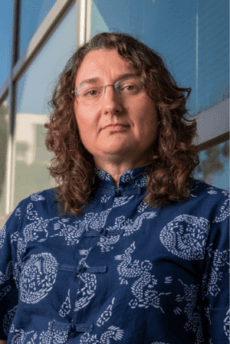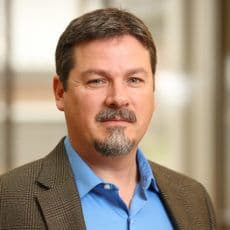ACS Catalysis is delighted to introduce three Executive Editors to the journal’s editorial team. Collectively, they bring 23 years of Associate Editor experience with the journal and will work with Professor Cathleen Crudden, Editor-in-Chief, to guide ACS Catalysis’s strategy, as well as support day-to-day activities like the assignment of new submissions. I recently sat down with […]

ACS Catalysis is delighted to introduce three Executive Editors to the journal’s editorial team. Collectively, they bring 23 years of Associate Editor experience with the journal and will work with Professor Cathleen Crudden, Editor-in-Chief, to guide ACS Catalysis’s strategy, as well as support day-to-day activities like the assignment of new submissions.
I recently sat down with each editor to discuss the new role. Read the interviews below.
Professor Paolo Fornasiero, University of Trieste

What do you hope to bring to ACS Catalysis in the Executive Editor role?
ACS journals share the philosophy of publishing articles with scientific rigor, as well as clear innovation and advancement in the specific field, and of being inclusive (diversity of editors, editorial advisory board members, authors, and reviewers). All these elements are the fundamentals of ACS Catalysis, too, and will continue to be the levers for the continuous development of the journal. I hope to bring my humanity in a selective process that could take into further account the needs and the transformations in the catalysis society. As a new Executive Editor, I hope to capture all the “weak signals” coming from the community as the first indicators of a change or an emerging topic that may become significant in the future. I will do my best to be an open-minded editor and ready to change opinions when necessary.
What is your research focus?
My main interests lie on the development of innovative materials that can be applied to heterogeneous catalysis. In particular, my research group and I investigate catalytic processes related to energy, environment and sustainability, overarching traditional thermal processes, photocatalysis, and electrocatalysis. All work is done with the hope of contributing to a more sustainable world and a better quality of life.
What initially attracted you to your field?
Serendipity played a role. At the very early stages of my career in research, I had in mind to carry out a project on homogeneous catalysis for my master’s degree. However, at that time, some funded projects on heterogeneous catalysis were available within the group; I was asked to switch. Hence, serendipity took its course. I discovered a new fascinating world, full of problems and opportunities for a young researcher, and I never turned back. I was especially attracted by the concrete aspects of heterogeneous catalysis, its close link to industry and application-focused research, which to me provided such a stimulating environment, very multidisciplinary and therefore inspiring.
Do you have a recent paper in an ACS journal that you wish to highlight?
Among my recent efforts, I wish to mention a Viewpoint article published with Michele Melchionna for the 10th anniversary of ACS Catalysis:
Updates on the Roadmap for Photocatalysis
ACS Catal. 2020, 10, 10, 5493–5501
DOI: 10.1021/acscatal.0c01204
It is a representative demonstration of how quickly science evolves, and in turn, how top journals need to keep up with that. It was also an effort (as an Associate Editor of the journal) to provide suggestions and guidelines for authors. Heterogeneous photocatalysis has become one of the most popular fields of research in recent times, attracting the interest of scientists with different backgrounds, and consequently, a massive number of articles. All this bulk of research has led to very quick progress in the field, dictating a fast tempo on how to adapt and renew the approaches to carry out photocatalytic experiments of high relevance. As a side effect, there remains a lack of a unified view by authors, who may not be aware of the latest discoveries. In particular, it is highly challenging to understand the real merit of new catalytic materials because of the many aspects that must be considered when reporting and comparing performance. Tables of comparisons tend to be subjectively laid out by many authors, escaping a general and harmonized method. Hence, it is necessary to set new and widely accepted laws, and I think this perspective article gives coordinates on how to orient within this “jungle” when reporting new work.
Professor Susannah Scott, University of California, Santa Barbara

What do you hope to bring to ACS Catalysis in the Executive Editor role?
Catalysis can seem like a very siloed research area, with distinct communities for heterogeneous, homogeneous, and biocatalysis. There are also different communities for thermal, electro-, and photocatalysis. Like many fields, catalysis can benefit from cross-fertilization between different areas of expertise. As an Executive Editor for ACS Catalysis, I hope to promote conversations between authors and reviewers from different sub-disciplines of catalysis so that they become more aware of each other and apply this broader expertise to generate deeper insight into catalytic phenomena. I also want to use my knowledge of catalysis research and researchers around the world to make sure that the journal publishes the best international contributions, judged by the best international reviewers, wherever they happen to be.
What is your research focus?
My research focuses on understanding the local structures of active sites in catalysts and the connection between their structure and activity. My approach is to synthesize well-defined active sites, in solution or on surfaces, and then to probe them using spectroscopy, kinetics, and mechanistic studies. Recently, I have broadened my scope to include a larger region of the catalyst beyond the local area of the active site, including modulation of the surface and the solvent to influence reaction outcomes. I also develop operando spectroscopic methods to probe dynamic catalyst behaviors.
What initially attracted you to your field?
I like working on scientific puzzles and thinking about their broader implications. Reaction mechanisms are like philosophical puzzles. Since there is no definitive evidence, we can debate them endlessly, but we can also use chemical and mathematical reasoning to move closer to the “truth” of a mechanism.
Do you have a recent paper in an ACS journal that you wish to highlight?
My most recent paper published in an ACS journal is:
P-Site Structural Diversity and Evolution in a Zeosil Catalyst
J. Am. Chem. Soc. 2021, 143, 4, 1968–1983
DOI: 10.1021/jacs.0c11768
It uses new techniques from solid-state NMR spectroscopy to extract information about the structure and relative hydrolytic stabilities of phosphoric acid oligomers confined in a self-pillared pentasil zeolite catalyst and to demonstrate the presence of framework-bound phosphoric acid sites which co-exist and co-evolve with the free oligomers. As the distribution of active site structures changes, the activity of the zeolite in acid-catalyzed reactions should change too, because its acidity depends on these structures.
Professor T. Brent Gunnoe, University of Virginia

What do you hope to bring to ACS Catalysis in the Executive Editor role?
I look forward to working with Cathy Crudden and the other Executive Editors to build on and continue the great success of ACS Catalysis as a leading journal in the field. It is our goal to serve the broad and diverse international catalysis community with integrity, high standards, and vision, in order to publish the most exciting advances in the field of catalysis.
What is your research focus?
The development and study of molecular and homogeneous catalysts applied to small molecule activation and functionalization. We pursue both thermal and electrocatalysis, and most of our research interests are in the areas of energy or large volume chemical synthesis.
What initially attracted you to your field?
I was fascinated by the ability to develop and leverage mechanistic understanding to implement changes in the molecular architecture of a catalyst active site that result in improved catalyst properties. It is very rewarding to elucidate a detailed mechanistic understanding, often through years of intense effort, of a catalytic process and to utilize that new knowledge to improve selectivity, activity and/or catalyst stability.
Do you have a recent paper in an ACS journal that you wish to highlight?
I have selected this article because it presents a detailed mechanistic elucidation that my group worked on, with our collaborators in the Zhang and Davis groups, for quite some time.
Mechanistic Studies of Single-Step Styrene Production Catalyzed by Rh Complexes with Diimine Ligands: An Evaluation of the Role of Ligands and Induction Period
ACS Catal. 2019, 9, 8, 7457–7475
DOI: 10.1021/acscatal.9b01480
